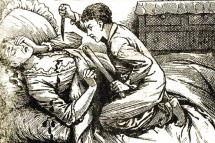The Wicked Boy: The Mystery of a Victorian Child Murderer

The Police News artist was sure to include the truncheon which was found at the murder scene in a suggestive manner in his drawing.
(by Kate Summerscale)
In the Prologue to this true-crime story, Summerscale describes a injured eleven-year old boy’s four mile walk along a dirt track in New South Wales, Australia, to report a crime. The prologue is intended to, and does, make us wonder about the connection between the plight of this Australian boy in 1930 and the life of a twelve-year old boy – Robert Coombes, the “wicked boy” of the title – who killed his mother in Plaistow, East London in 1895. That is the most interesting aspect of Summerscales’ book.
The story of how Robert Coombes (with or without the connivance of his brother Nathaniel) stabbed and killed their mother is less interesting. Robert was an intelligent, musical, conniving, cold-hearted child. He was excitable, morbid and given to terrible headaches. At trial Robert’s father gave evidence that physicians had explained that Robert was “afflicted with a preponderance of brain matter”. The excessive brain tissue caused crushing of the brain, which explained the child’s eccentricities and “phenomenal mental brightness”. If he lived to be fourteen years, then “the brain trouble would disappear”. This interesting and startlingly specific theory is one of several detailed by Summerscale. Was Robert an example of the ongoing degeneration of the human race, the congenitally vicious scion of poverty, or the warped product of having read too many “penny-dreadfuls”? (To those who find Summerscales’ extensive discussion of the reading matter for children at the time and its reputed effect on juvenile morals interesting we recommend Umberto Eco’s The Mysterious Flame of Queen Loana, reviewed here.)
Were Robert and Nathaniel abused and neglected children? They saw little of their rather passive father who was a ship’s steward. Their relationship to their mother remains unclear. Was she violent toward them, particularly Nathaniel, as Robert suggests? Why did the adolescent Robert sleep next to his mother when his father was away?
Naturally the media found this all too good to be true and what was true had to be embellished. The Police News artist was sure to include a truncheon found at the murder scene in a suggestive manner in the drawing under the heading ” Boys Murder Their Mother – Revolting Crime at Plaistow”
For whatever reason, Robert stabbed his mother twice through the heart with a recently purchased dagger, possibly bludgeoned her with the truncheon then went to Lord’s with his brother to watch the cricket. The boys later went to the wharves to find John Fox, a “half-wit”, and brought him home to “look after them”, as Fox had before when Mr Coombes was at sea. The three dwelt and slept in the back parlour of the Coombes’ home while Mrs Coombes rotted upstairs. Robert checked on her now and then, probably searching for further money and valuables. Fox seems not to have noted the smell or the clouds of flies at the upstairs window.
We will never know why Robert killed his mother. Summerscales’ enquiries naturally encompass the life of the poor dockland families, notorious murderers of the era, psychiatric history, theories of criminal responsibility and the peculiar legal customs of the time – Robert and Nathaniel had no legal defence at the early hearings and jurors were invited to stroll from the pub across the road to view Emily Coombes’ maggot-eaten face in a double coffin fitted with plate-glass.
Robert Coombes was found to be criminally insane and was sent to Broadmoor asylum. Like the poisoner Graham Young (fourteen at admission in 1962) Robert was housed in a specially designed block for children and (mostly) harmless eccentrics. Robert and his fellow inmates were dealt with according to a surprisingly lenient and humane regimen. The sad remnants of that innovative psychiatric therapy are to be seen in The Young Poisoner’s Handbook, a most excellent film based on Graham Young’s life. After 17 years Robert was released and went to live on a Salvation Army farm colony near Southend. In 1914 he joined his brother Nathaniel (against whom charges had not proceeded) in Australia. Robert volunteered for service in the AIF and became a bandmaster and stretcher-bearer. It could be said that he redeemed himself. Without giving too much away, that redemption occurred in April 1915, in Turkey,
After the Great War, Robert retired to the bush and lived a quiet life. He was well known, although his history does not seem to have been. He certainly became a force in the life of the young boy who walked the four miles on the dirt track. In the Epilogue the author introduces herself and her ruminations into the book. At first annoying, this turns out to be indispensable when she examines Robert’s later life, his relationship with others and the riveting question of what those people did and did not know about his life. The book ends on an intriguing and touching note.
There are elements of mystery in this story, the unknowableness of the human heart and mind, but it is not enough. All in all, this is a quick read, a rather thin book padded and fleshed out. Summerscales’ The Suspicions of Mr Whicher is better.
–
Leave a comment...
While your email address is required to post a comment, it will NOT be published.


0 Comments